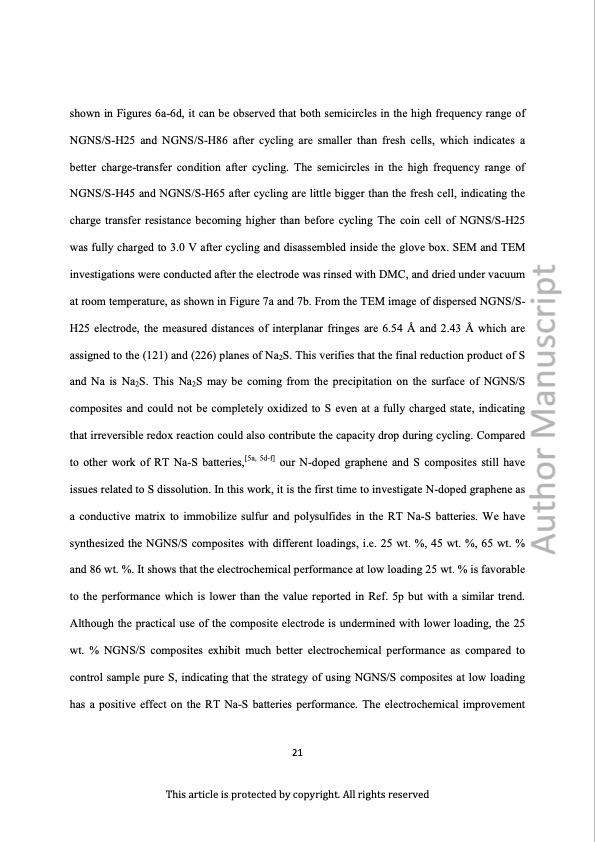
PDF Publication Title:
Text from PDF Page: 022
shown in Figures 6a-6d, it can be observed that both semicircles in the high frequency range of NGNS/S-H25 and NGNS/S-H86 after cycling are smaller than fresh cells, which indicates a better charge-transfer condition after cycling. The semicircles in the high frequency range of NGNS/S-H45 and NGNS/S-H65 after cycling are little bigger than the fresh cell, indicating the charge transfer resistance becoming higher than before cycling The coin cell of NGNS/S-H25 was fully charged to 3.0 V after cycling and disassembled inside the glove box. SEM and TEM investigations were conducted after the electrode was rinsed with DMC, and dried under vacuum at room temperature, as shown in Figure 7a and 7b. From the TEM image of dispersed NGNS/S- H25 electrode, the measured distances of interplanar fringes are 6.54 Å and 2.43 Å which are assigned to the (121) and (226) planes of Na2S. This verifies that the final reduction product of S and Na is Na2S. This Na2S may be coming from the precipitation on the surface of NGNS/S composites and could not be completely oxidized to S even at a fully charged state, indicating that irreversible redox reaction could also contribute the capacity drop during cycling. Compared to other work of RT Na-S batteries,[5a, 5d-f] our N-doped graphene and S composites still have issues related to S dissolution. In this work, it is the first time to investigate N-doped graphene as a conductive matrix to immobilize sulfur and polysulfides in the RT Na-S batteries. We have synthesized the NGNS/S composites with different loadings, i.e. 25 wt. %, 45 wt. %, 65 wt. % and 86 wt. %. It shows that the electrochemical performance at low loading 25 wt. % is favorable to the performance which is lower than the value reported in Ref. 5p but with a similar trend. Although the practical use of the composite electrode is undermined with lower loading, the 25 wt. % NGNS/S composites exhibit much better electrochemical performance as compared to control sample pure S, indicating that the strategy of using NGNS/S composites at low loading has a positive effect on the RT Na-S batteries performance. The electrochemical improvement 21 This article is protected by copyright. All rights reservedPDF Image | Nitrogen-Doped Graphene Nanosheets Composites as Cathode in Sodium-Sulfur Batteries

PDF Search Title:
Nitrogen-Doped Graphene Nanosheets Composites as Cathode in Sodium-Sulfur BatteriesOriginal File Name Searched:
slct-201701951.pdfDIY PDF Search: Google It | Yahoo | Bing
Sulfur Deposition on Carbon Nanofibers using Supercritical CO2 Sulfur Deposition on Carbon Nanofibers using Supercritical CO2. Gamma sulfur also known as mother of pearl sulfur and nacreous sulfur... More Info
CO2 Organic Rankine Cycle Experimenter Platform The supercritical CO2 phase change system is both a heat pump and organic rankine cycle which can be used for those purposes and as a supercritical extractor for advanced subcritical and supercritical extraction technology. Uses include producing nanoparticles, precious metal CO2 extraction, lithium battery recycling, and other applications... More Info
| CONTACT TEL: 608-238-6001 Email: greg@infinityturbine.com | RSS | AMP |